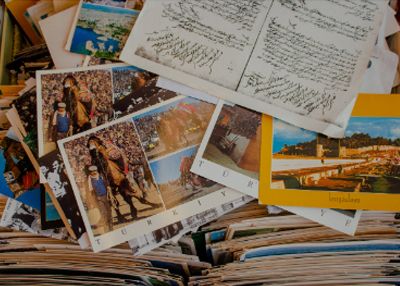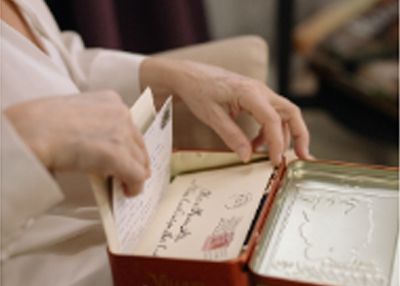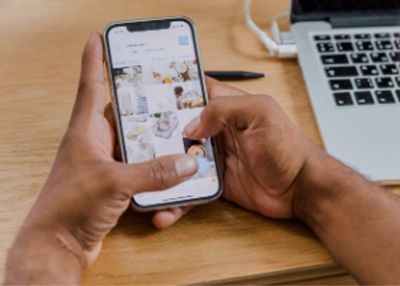Using Documents with PwD
Newspaper clippings, letters, postcards, greeting cards, sketches, certificates might help PwD reminding them of who they were, where they've been and what they have done and they can be helpful to run reminiscence based sessions.
Why is it useful?
- Documents are tangible objects that can elicit strong reminiscences.
- Triggering intact memories and stimulating conversations can improve the relationship between people with dementia and their families and carers
- Ultimately, this can improve the quality of care PwD receive
Activities:
1. Where to Find Memory Documents


What will we gain?
Documents can be really helpful in the framework of reminiscence activities, however sometimes they might be hard to find, for example if the PwD or his/her family hasn’t kept them, not recognising their potential value. In this sense, archives can offer documents that individuals often no longer possess: House plans, association records, company archives, local newspapers (advertisements, wedding notices, promotions, awards...) and provide them digitally.
ACTIVITY
Download the activity PDF:
Where to find memory documents
What can be memory documents?
- Working life: awards, honours, certificates, business cards, tickets or leaflets from company excursions ...
- Leisure: tickets or leaflets from events or holidays, cards, souvenirs ...
- Hobbies: sport newspaper clippings, record covers, certificates from ski races or swimming competitions, membership cards ...
- School: diplomas, report cards, pages from school books or notebooks...
- Family and Friends: postcards, birthday cards, birth or wedding certificates, invitations to birthday parties or weddings ...
- Articles and advertisements taken from newspapers corresponding with the PwD‘s interests
Where can I find memory documents?
- In one’s own family home
- At a neighbour‘s house
- Old newspapers and magazines
- In local archives or the museum
- On the internet
- Neighbourhood shops
- In the school the PwD attended
- In the place where the PwD worked
- In the association the PwD is/was part of
- ... and many more
What will we need?
- Collections of memory documents from the person or their family (e.g. certificates from ski races, weddings, travel souvenirs, identity cards, master craftsman's diplomas, honours, concert tickets, birthday cards)
- Documents retrieved from the offer of local/regional institutions. Most of them will have to be digitised before use.
- Meaningful documents retrieved from the internet
Points for reflection
- To be able to perform this activity, you should first become acquainted with the life story of the PwD
- You might need to try with different topics before finding those who are more stimulating for the PwD
- Observe the reaction of the PwD to understand which impact the activity has on him/her
Resources
2. How to Select Memory Documents?


What will we gain?
Choosing documents that are really meaningful for the PwD can help pursue the goal to use them to stimulate reminiscence and positive communication with others. On the other hand, persons with dementia may become overwhelmed when faced with too many visual stimuli, therefore it is important to be selective and choose a limited number of items to propose each time. It is also useful to choose documents that do not report too much text and that can be understood by looking at them (for example because they have a well-recognisable graphic).
ACTIVITY
Download the activity PDF:
How to select memory documents
Step 1: Think about what kind of memories you would like evoke?
Do I want to evoke memories about childhood, family, work, leisure or significant events in the PwD‘s life?
Consider: what are memory documents, what can be memory documents for the PwD I‘m working with? Is there something the PwD keeps referring to in your conversations? Can you think of memory documents to cover this topic?
Useful tip:
Choose documents that are significant for PWD and related to an autobiographical event/period of PWD’s life because autobiographical memories tend to remain preserved despite the disease.
Step 2: Getting started - where can I find memory documents in my region?
Start with family, friends and colleagues - nearly everyone has a small private collection of memory documents.
Then look around what‘s offered in your region by way of online collections. If you are looking for something specific, ask around in institutions related to the topic, e.g. associations, municipal archive, companies etc. Whenever you ask, make clear that you don‘t want to take away the documents, but merely want to photograph them.
Step 3: Select memory documents
Once you have chosen the topic and found some documents, how can you decide which ones are most suitable for the PwD?
Ask yourself:
- Is it interesting and meaningful for the PwD‘s life?
- Is it easily recognisable for the PwD? Consider visual contrast, resolution, not too much text, presence of visual cues that help recognition
- If not, can I improve the document‘s graphics (e.g. by choosing only a detail, editing it, putting it in context with another document or photo?)
What will we need?
- Brainstorming - what are memory documents, what can be memory documents for the PwD I’m working with
- Reflection on what I’ve already covered though photos - can memory documents cover topics I couldn’t find photos from? Can memory documents cover some topics even better?
Points for reflection
- When using the word “document” we can refer to a variety of items, including for example birthday cards, membership cards, headed papers… Do not only think about written documents with a lot of text.
- Observe the reaction of the PwD to the document chosen: are they meaningful for the person? Do they clearly show the activity / subject etc.?
- Which topics can be covered by memory documents - maybe even better then via photos? E.g. a diploma instead of a picture from the graduation ceremony?
3. How to Capture Documents and Prepare them for Upload to the BooM-Box


What will we gain?
We can identify the document we need from a variety of sources and we shall be able to capture and organise them properly (es. Based on tags, topics, sequence) on the APP to be able to use them with the PwD. Sometimes, the “right” document can be a detail of a broader document, or the original document might be deteriorated and needs to be improved before use. Learning how to do this helps to increase the use of the app and the positive impact of the activity.
ACTIVITY
Download the activity PDF:
How to capture documents and prepare them for upload to the BooM Box
Make sure that the document you use is easy to recognise - avoid small print, additional content that does not relate to the PwD and stick to documents with visual cues to help recognition.
Ask yourself if part of the document would be sufficient. – If so, cut out part of the document using your device‘s photo-editing software - see the activity PDF for examples.
What will we need?
- Not entire documents, only the most important parts to keep the app and its handling clearly arranged.
- Make the visual part (logo, graphics, headings) focus point
- A scanner or a camera for digitising documents
- Your mobile phone’s or computer’s photo-editing software
Points for reflection
- Is the way you have organised the documents functional? - Can you find what you are looking for?
- How is the quality of the documents? Can you work with them? Can you improve them?
EDUCATOR NOTES
- Identify which organisations / institutions can provide access to the resources looked for
- Acquire information about locally/regionally important events/places/businesses… Archives and museums can help to identify relevant content. Talk about what the participants think are relevant topics for your region and help them identify local content.
- Timelines and chronicles can also provide important information
- When using documents with PwD it is important to focus on:
- How to select the documents in relation to the life-story and interests of the PwD
- How to elicit an exchange around the document which is meaningful for the PwD
- How to manage emotional reactions to the use of documents (sadness, frustration, agitation etc.)
GLAM PROFESSIONALS NOTES
- Create a (small) selection of documents you can provide to people asking for content and care facilities
- Pre-select the right topics relevant to your region (working world, customs, places of identification, events... )
- Create a "sample exhibition" to generate interest and include all segments of the population regarding migration background, gender and social status.
- Be ready to provide technical guidance to users in relation to issues like copyrights, digitisation, download options
- Useful tips for interacting with a PwD who comes to your institution and people who accompany them: When engaging a PwD in a conversation about their past, it is important to ask questions in the proper way to avoid frustrating them. Plain, factual questions can be particularly challenging and stressful for PwD, who may fear they will get the answer wrong or be embarrassed about not being able to remember. Do not exclude the PwD by talking mainly to the person accompanying them.
CARERS NOTES
Which topics can you cover?
It is not unusual for a PwD to have a favourite story which they return to again and again. Quite often the story will relate to a time when the person felt particularly happy or proud. The message behind this repeated story may be that the person is now missing that sense of identity and purpose. Try to look for documents such as:
- Working life: awards, honours, certificates, business cards…
- Leisure: tickets from events or holidays, cards, souvenirs..
- Hobby: sport newspaper clippings, record covers, tailor papers…
- School: diplomas, pages from school books or notebooks…
- Family: postcards, birthday cards, birth or wedding certificates…
- Membership cards
You can contact your local archive/museum and explore if they can provide you a small selection of documents related with your area of interest
How to communicate with PwD?
When showing the pictures to the PwD, you should try to encourage a conversation but avoid creating frustration because of the memory problems the person experiences.
- Think about how you want to start the discussion on a particular topic beforehand. Avoid getting into too much detail, use more general language. You don’t have to mention specific events, you can talk about a topic in general.
- Do not ask 'Remember when...?' As this kind of question is often a reminder of memories lost.
- It’s better to lead the conversation and allow the person to join in. Instead of posing a question, try leading with ‘At that time, there was…’
- Sharing a memory yourself helps give clues for the sorts of things you will talk about, and may help the person to relax and recall their memories more easily, without fear of mixing things up or forgetting.
What to consider when working with a PwD through memory documents?
Not all memories are happy ones and it could be considered a gamble bringing up memories without any idea of what may surface. But it's not necessarily a bad thing if a person becomes emotional in a different way.
- Observe the reactions of the PwD to the documents you are showing: are they working well?
- Be flexible and ready to change your plans if you realise that the documents you are using are not helpful to stimulate the PwD
- Listen with kindness and understanding.
- After you listened, try to give positive feedback. You can say something like “You were so brave to take that on. You got through it, even though it was hard”.
- You don’t always need to steer the person to happier topics unless the person is becoming overly stressed. Many people navigate themselves out of bad memories in the storytelling process.
- Even sad memories can be good memories - you would be leaving out very large areas of life if you bypassed all possibly difficult content
- Before you leave, stay with the person a little longer and lead them into a more pleasant topic or memory to lift their mood.

 English
English  Polski
Polski  Deutsch
Deutsch  Hrvatski
Hrvatski  Italiano
Italiano  Ελληνικά
Ελληνικά  Svenska
Svenska